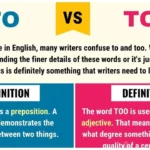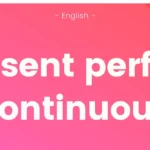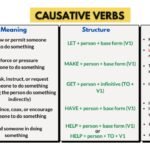Examples Of Past Continuous Tense: The Past Continuous Tense is used to describe actions or events that were in progress at a specific moment in the past. It provides context or background for another action that occurred at the same time or around that time.
Affirmative Sentences
Affirmative sentences in the Past Continuous Tense describe actions that were ongoing or in progress at a specific moment in the past. They provide context or background for other events that occurred during that time.
- I was reading a novel last night.
- She was cooking dinner when the power went out.
- They were playing soccer at the park.
- He was painting the house all afternoon.
- We were walking to the store when it started to rain.
- The children were building a sandcastle on the beach.
- She was studying for her exams during the weekend.
- I was watching a documentary on TV.
- They were having a picnic in the park.
- He was fixing his bike in the garage.
- We were listening to music at the party.
- She was chatting with her friends online.
- The dog was barking loudly in the backyard.
- I was writing a letter to my cousin.
- They were exploring the city when it started to snow.
- He was jogging in the park early in the morning.
- We were decorating the house for the festival.
- She was learning how to play the guitar.
- I was knitting a scarf for the winter.
- They were watching a movie together.
Negative Sentences
Negative sentences in the Past Continuous Tense describe actions that were not ongoing or in progress at a specific moment in the past. They indicate the absence of an action or the non-occurrence of an event that was supposed to be happening at that time.
- I was not watching TV when she called.
- She was not attending the meeting yesterday.
- They were not playing video games at that time.
- He was not eating lunch when you arrived.
- We were not driving to the beach last weekend.
- The children were not sleeping during the storm.
- She was not practicing her speech.
- I was not going to the gym in the evening.
- They were not studying for the test last night.
- He was not reading the newspaper when I visited.
- We were not having dinner at the restaurant.
- She was not talking to her colleagues.
- The cat was not sleeping on the bed.
- I was not waiting for you at the café.
- They were not working on the project.
- He was not fishing at the lake.
- We were not planning a trip to Europe.
- She was not running in the marathon.
- I was not cleaning the house.
- They were not rehearsing for the play.
Interrogative Sentences
Interrogative sentences in the Past Continuous Tense are used to ask questions about actions that were ongoing or in progress at a specific moment in the past. These questions seek information about the state or activity that was happening during that time.
- Was I reading the right book?
- Was she cooking dinner when you arrived?
- Were they playing soccer at the park?
- Was he painting the house yesterday?
- Were we walking to the store at that time?
- Were the children building a sandcastle?
- Was she studying for her exams last weekend?
- Was I watching TV during the storm?
- Were they having a picnic in the park?
- Was he fixing his bike when you saw him?
- Were we listening to music at the party?
- Was she chatting with her friends online?
- Was the dog barking loudly?
- Was I writing a letter to my cousin?
- Were they exploring the city when it snowed?
- Was he jogging in the park early in the morning?
- Were we decorating the house for the festival?
- Was she learning to play the guitar?
- Was I knitting a scarf for winter?
- Were they watching a movie together?
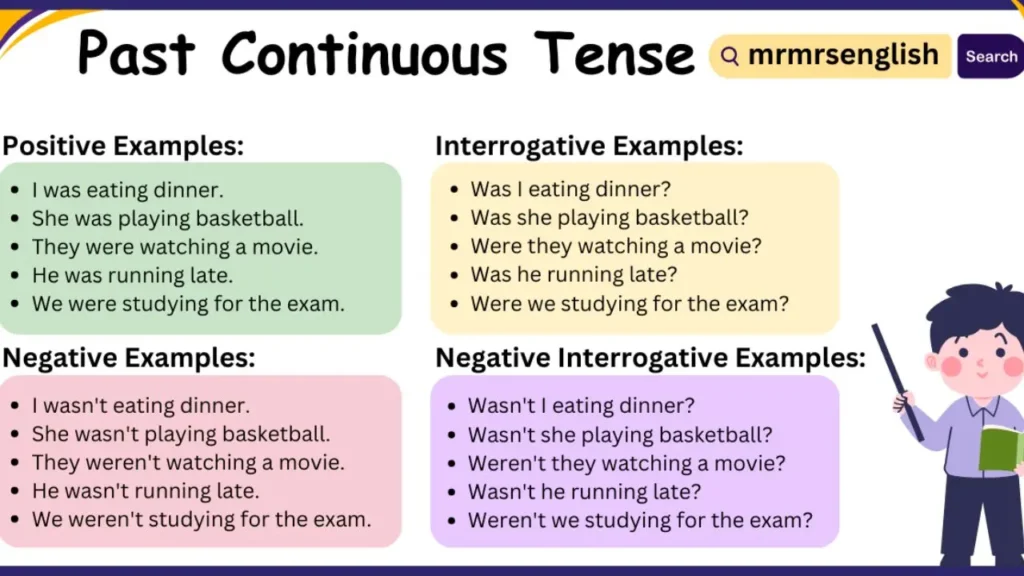
WH-word Sentences
WH-word sentences in the Past Continuous Tense are used to ask specific questions about actions that were ongoing or in progress at a particular time in the past. These questions use WH-words (who, what, where, when, why, how) to gather detailed information about the ongoing action or event.
- What was I reading last night?
- Where was she cooking dinner?
- Why were they playing soccer in the park?
- What was he painting all afternoon?
- Where were we walking when it started to rain?
- What were the children building on the beach?
- Why was she studying for her exams over the weekend?
- What was I watching on TV?
- Where were they having a picnic?
- What was he fixing in the garage?
- What were we listening to at the party?
- Who was she chatting with online?
- What was the dog barking at?
- Why was I writing a letter to my cousin?
- Where were they exploring when it started to snow?
- What time was he jogging in the park?
- What were we decorating for the festival?
- How was she learning to play the guitar?
- What was I knitting for the winter?
- Why were they watching a movie?
Negative Interrogative Sentences
Negative interrogative sentences in the Past Continuous Tense are used to ask questions that involve a negative assumption about actions or events that were ongoing or in progress at a specific moment in the past. They are used to inquire about something that one might expect not to have happened during that time.
- Wasn’t I reading the right book?
- Wasn’t she cooking dinner when you arrived?
- Weren’t they playing soccer at the park?
- Wasn’t he painting the house yesterday?
- Weren’t we walking to the store at that time?
- Weren’t the children building a sandcastle?
- Wasn’t she studying for her exams last weekend?
- Wasn’t I watching TV during the storm?
- Weren’t they having a picnic in the park?
- Wasn’t he fixing his bike when you saw him?
- Weren’t we listening to music at the party?
- Wasn’t she chatting with her friends online?
- Wasn’t the dog barking loudly?
- Wasn’t I writing a letter to my cousin?
- Weren’t they exploring the city when it snowed?
- Wasn’t he jogging in the park early in the morning?
- Weren’t we decorating the house for the festival?
- Wasn’t she learning to play the guitar?
- Wasn’t I knitting a scarf for winter?
- Weren’t they watching a movie together?
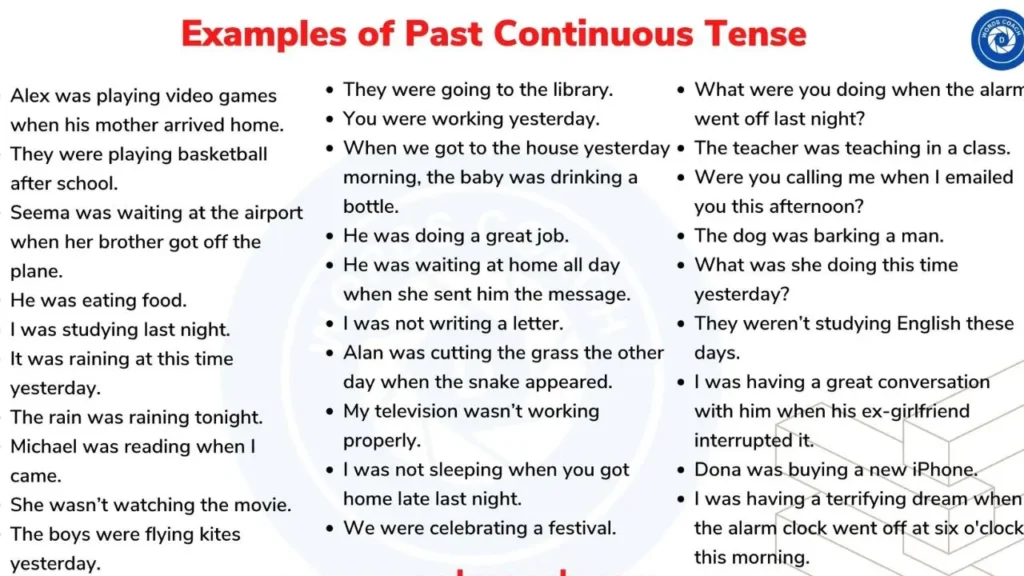
FAQ about Past Continuous Tense-
1. What is the Past Continuous Tense?
Answer: The Past Continuous Tense is used to describe actions or events that were ongoing at a specific moment in the past. It sets the scene for another action or event that was occurring at the same time or around the same time.
Structure:
- Affirmative: Subject + was/were + verb (present participle) + other elements.
- Negative: Subject + was/were + not + verb (present participle) + other elements.
- Interrogative: Was/Were + subject + verb (present participle) + other elements?
- WH-word: WH-word + was/were + subject + verb (present participle) + other elements?
- Negative Interrogative: Was/Were + subject + not + verb (present participle) + other elements?
2. When is the Past Continuous Tense used?
Answer: The Past Continuous Tense is used in several situations:
- To describe an ongoing action in the past: “I was reading a book.”
- To show a past habitual action: “He was often visiting his grandparents.”
- To set the scene for another action: “She was cooking when the phone rang.”
- To describe simultaneous actions in the past: “They were playing soccer while I was watching.”
3. How is the Past Continuous Tense formed?
Answer: The Past Continuous Tense is formed using the past tense of the verb “to be” (was/were) + the main verb in its present participle form (verb + -ing).
Example:
- Affirmative: “She was studying for her exam.”
- Negative: “She was not studying for her exam.”
- Interrogative: “Was she studying for her exam?”
- WH-word: “What was she studying for?”
4. Can the Past Continuous Tense be used with specific time expressions?
Answer: Yes, the Past Continuous Tense can be used with time expressions to specify when the action was taking place. Common time expressions include “at that time,” “when,” “while,” “during,” and “in the past.”
Example:
- “I was watching TV at 8 PM.”
- “She was reading a book when the power went out.”
5. How does the Past Continuous Tense differ from the Past Simple Tense?
Answer: The Past Continuous Tense describes actions that were ongoing at a specific moment in the past, while the Past Simple Tense describes actions that were completed in the past. The Past Continuous often sets the scene or shows simultaneous actions, while the Past Simple often indicates a completed action.
Example:
- Past Continuous: “I was eating dinner when he called.”
- Past Simple: “I ate dinner last night.”
6. Can the Past Continuous Tense be used with stative verbs?
Answer: Generally, stative verbs (which describe a state rather than an action) are not used in the Past Continuous Tense. Stative verbs include verbs like “know,” “believe,” “love,” and “belong.” However, in some cases, stative verbs may be used in the continuous form to emphasize the process or temporary nature of the state.
Example:
- Standard: “I knew the answer.”
- Continuous (Emphasizing Process): “I was knowing the answer (rarely used, mostly for emphasis).”
7. What is the role of the Past Continuous Tense in conditional sentences?
Answer: The Past Continuous Tense is often used in conditional sentences to describe an ongoing action in the past that was interrupted by another event. The action being interrupted is in the Past Continuous, while the interrupting event is in the Past Simple.
Example: “She was reading a book when the lights went out.”
8. Can the Past Continuous Tense be used in reported speech?
Answer: Yes, the Past Continuous Tense can be used in reported speech to reflect an ongoing action from the past.
Example:
- Direct Speech: “I was studying for the exam,” she said.
- Reported Speech: She said that she was studying for the exam.
9. Are there any common mistakes to avoid with the Past Continuous Tense?
Answer: Common mistakes include:
- Using the Past Continuous Tense for completed actions instead of the Past Simple.
- Forgetting to use “was/were” with the subject.
- Using stative verbs incorrectly in the continuous form.
- Confusing simultaneous actions (which can be expressed with the Past Continuous) with sequential actions (which should use the Past Simple).
Example of Mistake: “I was finished my homework.” (Correct: “I finished my homework.”)
10. How do I know whether to use the Past Continuous or Past Simple in a sentence?
Answer: Use the Past Continuous to describe ongoing actions or background scenes, and use the Past Simple for completed actions or events. When describing two actions happening at the same time, the Past Continuous is often used for the background action, and the Past Simple for the interrupting action.
Example: “I was walking in the park (Past Continuous) when I saw a dog (Past Simple).”
Read Also:

